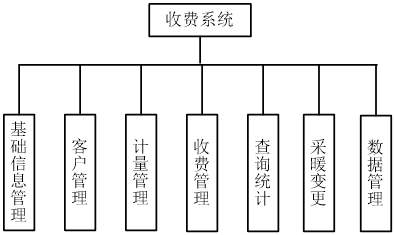1. Network environment planning
Almost 100% of the information platforms in heating enterprises need to work through the network. The network is like a highway, connecting different devices and terminals, so that data can be transmitted and shared in real time. But on the other hand, network congestion and hacker intrusion have brought us great losses, even disasters. Therefore, we need to make different plans and requirements for different IT systems, application scenarios, and security levels in the process of informatization construction, so that we can enjoy the benefits of informatization while achieving sustainable development.
Rule 1: Production operation control system, no access to the Internet
In scenarios with very high safety levels, such as coal-fired boilers, gas-fired boilers, and pulverized coal boilers, on-site staffing is required during operation. With the continuous progress of grid connection, the number of heat sources in general heating enterprises is also small, so only on-site monitoring and operation of the control system are required. If the heating enterprise wants to further get through the heating operation data of heat source, heat exchange station, unit and residents, realize monitoring and carry out big data analysis, it can collect the operation parameters of the control system by setting an intermediate server, and transfer them to the data center or other systems.
Rule 2: The unattended system of heat exchange station is controlled by LAN and supervised by Internet.

Heating enterprises often have dozens, or even hundreds, of heat exchange stations distributed near each community. The traditional management method is that each heat exchange station is equipped with two or three staff for on-site operation. With the rise of unattended heat exchange stations, most heating enterprises have realized unattended operation, greatly reducing the operation and management costs.
There are many heat exchange stations with scattered locations, so it is suitable to improve efficiency through remote management. GPRS DTU technology is used to collect the operating parameters of heat exchange stations. Conditional heat exchange stations can also use dedicated lines, and the dedicated line scheme can support video monitoring at the same time.
The unattended heat exchange station is divided into two parts: supervision and control. We suggest decentralized supervision and centralized control, because so many real-time data of heat exchange stations have been centralized during the heating period, and most of the energy consumption control strategies can be preset without manual adjustment, so the personnel on duty can be arranged for real-time supervision and remote control, This part is realized by private network or local area network to ensure the quality and reliability of instructions. The supervision part can not open the control authority, but can open it to leaders at all levels and leaders of the dispatching center, so that the relevant leaders can access the mobile terminal, realize real-time viewing at any time, anywhere, and receive operation fault and alarm information.
Rule 3: The heat metering meter or temperature control valve platform can be opened for heat users through mobile Internet.
The heat consumption data of heat metering and temperature control valve is, on the one hand, the basis for heating enterprises to charge, and on the other hand, the tool for heat users to adjust temperature. Therefore, the remote control system of heat metering and temperature control valve can be opened to customers through APP.
The influence scope of household meters and temperature control valves is a single user, and there are thousands of acquisition and control points. It is more suitable to transmit data to the central server through concentrator and GPRS. The central server publishes data remote viewing and control services through the Internet.
Rule 4: The internal business management system will partially open Internet services as required.
With the refinement process of heating enterprise management, there will be more and more internal information platforms, ranging from a few to more than a dozen. In this regard, expert consultants are required to carry out targeted analysis according to the characteristics of each system and plan network access permissions.
Heating management system, for large and medium-sized heating enterprises, the core business system often runs in the LAN system, or in the VPN and digital certificate environment. At the same time, it also needs to connect with the collection of multiple banks. In the process of connecting with the bank, a front-end computer must be set up to isolate the internal network and the external network, so as to achieve logical isolation, which not only ensures the security of the banking system, but also ensures the data security of the heating enterprise. As for the third-party collection platforms such as WeChat and Alipay, it is necessary for hot users to log in directly to handle business, so at least 80 ports need to be opened to the outside to realize the connection with external systems. For the scenario where the internal staff of the heating enterprise need to conduct on-site office and remote office through the mobile APP, we need to shield the core business system and properly open some business interfaces to the outside world, including on-site charging, temperature measurement, maintenance, inspection, patrol inspection, etc., so as to provide convenience to the staff as far as possible on the premise of achieving data security.
Other publicity platforms such as heating enterprise website platform and WeChat public account can be directly published on the public network.
2. Hardware platform construction
The hardware environment refers to the infrastructure for the informatization construction of heating enterprises. The informatization of heating enterprises is generally backward, so the IT infrastructure is uneven, and the solutions are diverse, but generally divided into the following situations:
Rule 1: Small and medium-sized heating enterprises without IT infrastructure are recommended to use virtual machines to quickly build IT infrastructure services.
Small and micro heating enterprises can rent virtual machine hosting services and technical support services. Under the heating cloud service mode, heating enterprises no longer need to set up a network center, configure high-end servers and professional network management. Each charging computer can only be charged if it can access the Internet, and field staff can directly access it if they only need mobile APP. Traditional servers worry about four problems: host hardware problems, network failures, performance and stability, and data security, all of which have been systematically solved. Based on the system backup of heating enterprises, in fact, no matter group heating enterprises or small and medium-sized heating enterprises, they can give priority to virtual machines to build safe and stable network services. At least the services we often use, such as charging, customer service, temperature measurement, inspection, maintenance, patrol inspection, and unattended service, can be launched in cloud services.
Rule 2: Small and medium-sized heating enterprises with IT foundation can build simple machine rooms.
It is suitable for small and medium-sized heating enterprises with simple business, no Internet and no mobile demand. A common server can be configured to build charging, customer service, finance and other services, and other computers can be directly connected to the LAN. If the server is not connected to the Internet, it does not support remote office and mobile access.
Rule 3: Medium sized heating enterprises on a large scale can build professional computer rooms.
Medium heating enterprises often have standardized computer rooms, sufficient network bandwidth, independent public network IP, full-time network management personnel, and supporting firewall facilities. Such heating enterprises can choose to purchase their own server equipment, set up special lines from operators, have independent IP, and apply for 5M/10M exclusive bandwidth. The machine room should be equipped with a high-capacity UPS, and if possible, it should be equipped with a two-wire power grid to avoid accidental power failure and network disconnection.
Since heating enterprises have many information businesses, including finance, office work, charging, customer service, heat network monitoring, etc., deploying all information platforms to professional computer rooms has some advantages in terms of stability and maintainability.
Rule 4: Group and large heating enterprises adopt private cloud and virtualization technology.
In the traditional infrastructure environment, server demand is increasing, and room space and power become bottlenecks. The system management personnel are busy with new deployment and "fire fighting", and have no energy to carry out management improvement. The technical complexity of the traditional computer room makes the deployment time longer and longer, leading to the extension of the application online time. With the continuous increase of applications, the number of servers also increases. The acquisition cost of servers and storage is high, and the maintenance cost is increasing. The resource allocation and deployment of the data center are mostly manual, which will lead to high error rate, low efficiency and low flexibility. Resources cannot be scheduled and shared in real time and dynamically in the entire data center, so that server, storage and network resources cannot be fully utilized. The application servers are stand-alone. When the hardware needs maintenance, upgrading or hardware failure occurs, the business system will be interrupted for a long time, affecting the business continuity.
To sum up, the traditional computer room construction has many shortcomings, while the private cloud construction has alleviated the impact of the above problems to a certain extent, and can realize server virtualization, network virtualization, storage virtualization, and desktop virtualization. It breaks the traditional one server one application model and achieves unified resource management and on-demand allocation. After cloud, the virtual machine has all the components on the physical machine and can be fully compatible with standard operating systems, device drivers and applications. First, the number of physical servers and related hardware devices will be reduced accordingly after cloud; Secondly, it reduces the cost of operation and maintenance, and also improves the management efficiency.
We recommend VMware's server virtualization solution. vSphere is the industry-leading virtualization platform for building cloud computing infrastructure. VSphere implements a complete, efficient, and secure virtualization platform through a complete set of applications and infrastructure services in computing, storage, networking, availability, security, and automation.
3. Software platform construction
Most of the informatization construction roads of heating enterprises are rugged, even overwhelming, and have witnessed too many cases of informatization failure. A large part of this is due to the lack of understanding of informatization by the leaders of heating enterprises and their simple thinking, which led them to retreat after encountering difficulties. Another part of the reason is that enterprises and manufacturers are inexperienced and cross the river by touching stones, which leads to insufficient software scalability and isolated information islands between systems many years later.
In fact, the main information platforms can be divided into three categories: administrative management (such as human resources, OA, finance, etc.); Business management (fees, customer service, etc.); Production and operation (equipment patrol inspection, heat supply network monitoring, production scheduling, etc.). In the primary stage of informatization, we must solve three problems, so that we can form a situation of continuous iteration and incremental development on the future informatization road. First, in the process of administrative informatization construction, it is necessary to maintain the human organization structure of the heating enterprise as a whole, realize the unified management of the enterprise's organizational structure, and provide personnel information sharing, single sign on and authorization management for other systems; Second, in the informatization of operation and management, it is necessary to clarify the information of heat users, not only to calculate the area and cost, but also to fully improve the information of heat users to provide basic data support for production systems; Third, in the production and operation informatization, it is necessary to establish equipment and data codes of heating enterprises, establish the format and standards of equipment and data collection, and realize the standard exchange format of equipment data such as heat source, heat exchange station, pipe network, valve table, etc. To sum up, we can improve the standardization and micro service of heating data center from these three aspects, so as to promote the convergence and linkage of various information platforms of heating enterprises.
4. Information security management
Although the state has formulated relevant laws and policies, in addition to relying on the deterrent power of the law, enterprises should start from management and technology, and strengthen the security management of enterprise resources in all aspects. In order to greatly reduce computer damage, enterprises must integrate special policies and procedures into the management of information resources and do a good job in control. To control the system information resources, the following points must be done well:
Rule 1: User management
Check whether the user has access to system resources in advance. It requires not only checking the user name, but also checking the user's password. Only when both of them match the password set in the system, can the system resources be used. This prevents unauthorized people from accessing system resources.
A further way, which is also being used by PayEase, is to issue encryption U shields to all users logging into the system. It can also establish a digital certificate for each user to ensure the legitimacy of the login user.
Rule 2: Data Permission Management
There are many users in the heating information management system. In fact, these users have different access rights to enterprise resources. Therefore, the administrator of enterprise system resources must grant appropriate permissions to corresponding users. Especially for group heating enterprises, the operating users of branch companies and heating stations can only browse or edit the relevant data within their own departments.
Rule 3: Process management
The information system is often composed of data and processes, especially the collaboration between superior and subordinate or multiple departments needs processes to connect. Therefore, in the process of informatization construction, the key data adjustment can take effect only after the process review, including the cost reduction and other operations in the charging system, so as to make the work more consistent with the enterprise specifications and ensure the preciseness of the data.
Rule 4: Establish system operation log
The purpose of establishing the system operation log is to confirm and track things related to the processing and use of system data resources. It can provide information such as the specific use of the inspection system, and can help find authority problems, system failures, etc.





